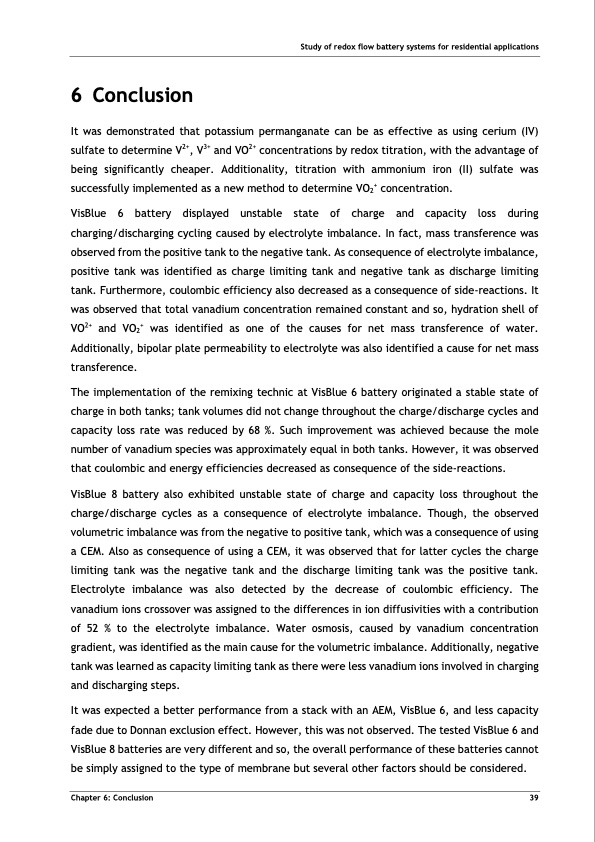
PDF Publication Title:
Text from PDF Page: 050
Study of redox flow battery systems for residential applications 6 Conclusion It was demonstrated that potassium permanganate can be as effective as using cerium (IV) sulfate to determine V2+, V3+ and VO2+ concentrations by redox titration, with the advantage of being significantly cheaper. Additionality, titration with ammonium iron (II) sulfate was successfully implemented as a new method to determine VO2+ concentration. VisBlue 6 battery displayed unstable state of charge and capacity loss during charging/discharging cycling caused by electrolyte imbalance. In fact, mass transference was observed from the positive tank to the negative tank. As consequence of electrolyte imbalance, positive tank was identified as charge limiting tank and negative tank as discharge limiting tank. Furthermore, coulombic efficiency also decreased as a consequence of side-reactions. It was observed that total vanadium concentration remained constant and so, hydration shell of VO2+ and VO2+ was identified as one of the causes for net mass transference of water. Additionally, bipolar plate permeability to electrolyte was also identified a cause for net mass transference. The implementation of the remixing technic at VisBlue 6 battery originated a stable state of charge in both tanks; tank volumes did not change throughout the charge/discharge cycles and capacity loss rate was reduced by 68 %. Such improvement was achieved because the mole number of vanadium species was approximately equal in both tanks. However, it was observed that coulombic and energy efficiencies decreased as consequence of the side-reactions. VisBlue 8 battery also exhibited unstable state of charge and capacity loss throughout the charge/discharge cycles as a consequence of electrolyte imbalance. Though, the observed volumetric imbalance was from the negative to positive tank, which was a consequence of using a CEM. Also as consequence of using a CEM, it was observed that for latter cycles the charge limiting tank was the negative tank and the discharge limiting tank was the positive tank. Electrolyte imbalance was also detected by the decrease of coulombic efficiency. The vanadium ions crossover was assigned to the differences in ion diffusivities with a contribution of 52 % to the electrolyte imbalance. Water osmosis, caused by vanadium concentration gradient, was identified as the main cause for the volumetric imbalance. Additionally, negative tank was learned as capacity limiting tank as there were less vanadium ions involved in charging and discharging steps. It was expected a better performance from a stack with an AEM, VisBlue 6, and less capacity fade due to Donnan exclusion effect. However, this was not observed. The tested VisBlue 6 and VisBlue 8 batteries are very different and so, the overall performance of these batteries cannot be simply assigned to the type of membrane but several other factors should be considered. Chapter 6: Conclusion 39PDF Image | Tubular Vanadium Air Redox‐flow battery

PDF Search Title:
Tubular Vanadium Air Redox‐flow batteryOriginal File Name Searched:
204521.pdfDIY PDF Search: Google It | Yahoo | Bing
Salgenx Redox Flow Battery Technology: Salt water flow battery technology with low cost and great energy density that can be used for power storage and thermal storage. Let us de-risk your production using our license. Our aqueous flow battery is less cost than Tesla Megapack and available faster. Redox flow battery. No membrane needed like with Vanadium, or Bromine. Salgenx flow battery
| CONTACT TEL: 608-238-6001 Email: greg@salgenx.com | RSS | AMP |